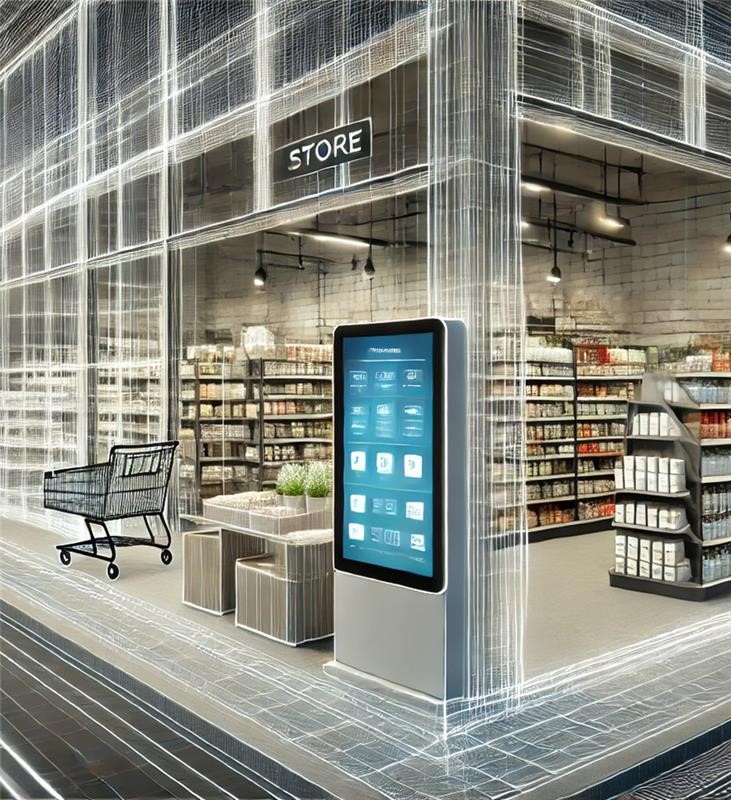Retailers lose millions annually due to inefficiencies in their strategies, from pricing and inventory mismanagement to poorly executed merchandising. But what if there were a faster, smarter way to get it right the first time—and save millions in the process? Enter retail AI simulations, an approach that is rewriting the playbook for the retail industry.
Simulations have long been a powerful tool in retail, allowing businesses to test concepts, pricing strategies, and store layouts without the costly risks of real-world execution. But now, AI technologies have supercharged simulation capabilities, enabling retailers to analyze customer behavior, optimize strategies, and make smarter decisions faster than ever before.
The fusion of artificial intelligence and proven simulation methods is a game changer for retail businesses. By leveraging AI-driven insights and automating processes such as inventory management, pricing, and merchandising, retailers can streamline operations, improve customer satisfaction, and dramatically boost profitability. Retail is changing fast, and businesses that embrace the power of AI gain a competitive edge, while those that hesitate risk falling behind.
Ready to find out how AI simulations can transform your retail operations? Let’s explore the cutting-edge AI solutions driving this revolution.
What Are Retail Simulations?
At InContext, we live and breathe retail simulations. For years we have been helping retailers and brands refine strategies, optimize operations, and achieve measurable success through digital twin environments. These digital twins recreate the shopping experience digitally, enabling businesses to test store layouts, product placements, pricing strategies, and marketing concepts before implementing them in the real world.
Why do simulations matter? They eliminate the guesswork and costly trial-and-error methods that often accompany real-world testing. By leveraging our tools, retailers can uncover actionable insights, avoid risks, and save valuable time and resources. We’ve seen firsthand how simulations transform retail by providing a clear, data-backed path to success.
How Retail Simulations Work
Retail simulations operate by creating detailed digital twin environments that mimic real-world retail settings. This process allows businesses to test strategies and gather insights before implementing them. The steps typically include:
-
- Data collection. Retailers provide key data, such as current store layouts, product inventories, and shopper behaviors.
- Virtual environment creation. Using advanced digital twin software, a 3D virtual model is created, mirroring the retail environment.
- Testing scenarios. Retailers can experiment with layouts, pricing strategies, product placements, and promotions to evaluate their impact.
- Analysis. The simulation provides metrics and insights, such as traffic flow, shopper engagement, and sales forecasts, enabling data-driven decisions.
This structured approach eliminates costly guesswork, reduces risks, and accelerates time to market for new strategies and allows retailers to:
Optimize Store Layouts
Retail simulations enable retailers to design and test store layouts that maximize sales while minimizing customer frustration. By using simulation data to analyze traffic patterns and customer behaviors, businesses can create optimized layouts before implementation.
For instance, clients can test various scenarios, such as adjusting aisle widths to improve navigation, reorganizing departments to create a more logical flow, or placing high-margin products in high-traffic areas to boost visibility. They can also evaluate how promotional displays or seasonal setups impact shopper behavior and sales metrics. These insights allow retailers to implement data-driven layouts that enhance the shopping experience and drive revenue growth.
Perfecting Product Placement
Retail simulations enable businesses to virtually test product placement and shelving strategies to determine the most effective configurations for boosting sales. This ensures high-performing SKUs are strategically prioritized and easily accessible to customers.
One of InContext’s global spirits manufacturer clients aimed to convince a large national retailer to rearrange their spirits aisles. They created a 3D test environment, then compared sales metrics, shopper behaviors, and product findability to those of the existing layout. The results were remarkable: Category sales increased by over 10%, with more customers trading up to premium products.
Ensure Product Launch Success
By allowing businesses to test and refine their strategies before introducing products to the market, retail simulations are a powerful way to help product launches succeed. For instance, we worked with a manufacturer tasked with selecting the best product launch strategy from 17 potential in-store executions.
Using our virtual testing tools, the client identified which concepts resonated most with shoppers, eliminating ineffective ideas early and pinpointing the ideal product placement and shelf arrangement, ensuring a strong sales impact. The validated concept achieved a 100% retailer execution rate, with sales aligning closely to simulation predictions 36 weeks post-launch. By leveraging retail simulations, the client avoided the time and expense of mock store setups while confidently, and successfully, launching their product.
However, simulations aren’t just about planning; they’re also about adaptability. Consistent monitoring enables retailers to make data-driven adjustments so that they can continue to hone their tactics and avoid over-commitment to ineffective strategies.
The Next Evolution in Retail Simulations
Although current retail simulations are effective, the retail landscape is more complex than ever, with customers bombarded by information and shifting preferences at unprecedented speeds. In fact, a PwC report found that 73% of consumers cite experience as a key factor in their purchasing decisions—yet those experiences are shaped by constantly changing expectations. At the same time, 40% of customers switched brands in the prior three months in search of better value, according to a McKinsey & Company study. This rapid shift in consumer values means relying solely on historical data or traditional simulations may no longer suffice.
Retailers today must predict and meet customer needs in a world where preferences change overnight. Traditional methods, while valuable, often lack the adaptability and speed needed to keep up with these trends. That’s where AI-powered retail simulations come in. By leveraging artificial intelligence, retailers can process vast amounts of real-time data, predict future behaviors, and dynamically adjust strategies to meet evolving demands.
Why AI Changes the Game
AI represents the fastest path to retail success by drastically reducing the time required for testing and decision-making compared with traditional methods. This transformative technology empowers retailers to move from months-long processes to actionable insights delivered in days, enabling quicker implementation and faster ROI.
By processing vast amounts of data in real time and providing previously unattainable insights, AI allows retailers to adapt to complex, ever-changing scenarios with precision. Among the benefits of AI simulations:
-
- Speed. Pricing changes or store layout adjustments that once took weeks to model can now be tested and analyzed in hours, giving retailers a critical competitive edge.
- Cost-efficiency. By automating complex analyses, AI eliminates much of the manual effort required in traditional simulations. This not only lowers operational costs but also ensures more-precise predictions, reducing waste and resource misallocation.
- Scalability. AI’s ability to handle larger datasets and intricate scenarios makes it an ideal solution for retailers operating at scale. Whether it’s managing multiple locations or omnichannel strategies, AI ensures that simulations remain effective and adaptable as businesses grow.
With AI as the driving force, retail simulations have evolved into tools that do more than solve problems; AI-enabled simulations anticipate them, so retailers can operate more efficiently and profitably in a fast-paced market.
The Role of Data in AI-Powered Simulations
Data is the cornerstone of AI-powered simulations, serving as the foundation for every insight, prediction, and decision. However, it’s not just about having data—it’s about having the right data. High-quality, expansive datasets are what set apart impactful simulations from those that fail to deliver actionable results. The accuracy of AI simulations hinges on the richness, relevance, and precision of the data being used.
Many companies struggle with incomplete or low-quality data, which limits their ability to produce reliable insights. At InContext, our robust database of more than 2 million shopping trips and growing provides a vast and diverse dataset enabling hyper-accurate results tailored to real-world retail environments.
Why Data Quality Matters
-
- Identifying subtle patterns. AI thrives on finding connections that traditional methods often overlook. High-quality data allows our AI algorithms to uncover subtle correlations, such as how specific shelf placements affect customer buying decisions or how shoppers respond to different aisle arrangements. These insights empower retailers to make smarter merchandising decisions that boost sales and improve the customer experience.
- Delivering targeted insights. With a comprehensive dataset, our simulations can provide nuanced insights that account for regional preferences, shopping behaviors, and demographic trends. This level of granularity helps retailers optimize customer engagement strategies across channels, whether in store or through eCommerce platforms.
- Ensuring accuracy. Reliable data ensures that our simulations predict real-world outcomes with up to 96% accuracy. Our database’s depth enables us to predict the impact of new layouts or pricing strategies with unmatched precision, allowing retailers to act with confidence.
Our datasets provide the breadth and depth needed to model diverse scenarios and generate insights that are both predictive and actionable. By combining this data with advanced AI algorithms, we deliver more-accurate results more quickly than ever before so that retailers can adapt to the complexities of the modern retail landscape.
The Future of AI in Retail Simulations
As we look to the future, the role of data in AI-powered simulations highlights a pivotal truth: Retail success increasingly depends on making smarter, faster decisions based on high-quality information. The ability to harness data effectively has already transformed retail operations, but the pace of change is accelerating. AI simulations, driven by precise and expansive datasets, are unlocking opportunities that were previously out of reach.
Retailers are now positioned to leverage these tools to anticipate trends, predict customer needs, and refine strategies in real time. More than just a competitive advantage, this level of adaptability is becoming a necessity. The question isn’t whether to adopt AI-driven solutions but how quickly businesses can integrate them into their operations to stay ahead.
What’s Next for AI in Retail?
-
- Hyper-personalized experiences. AI will enable retailers to deliver even more tailored shopping experiences, both online and in store. By analyzing individual customer data in real time, it will facilitate the creation of personalized offers, product recommendations, and marketing messages that resonate with each shopper.
- Advanced predictive analytics. The future of retail simulations lies in their ability to predict trends and customer needs before they happen. With advancements in machine learning and real-time data processing, AI-powered simulations will help retailers anticipate inventory demands, optimize pricing strategies, and respond to market changes instantly.
- Seamless omnichannel integration. As eCommerce and brick-and-mortar stores continue to converge, AI will play a pivotal role in creating a unified shopping experience. From dynamic in-store displays to synchronized online recommendations, retailers will be able to ensure consistency and engagement across all channels.
Adapting to these changes is becoming increasingly important. Retailers that invest in AI today can position themselves as innovators and set the pace for the industry. Those that delay may find it challenging to keep up in a rapidly evolving market.
If you’re ready to embrace the future of retail and take your business to the next level, contact InContext today.




